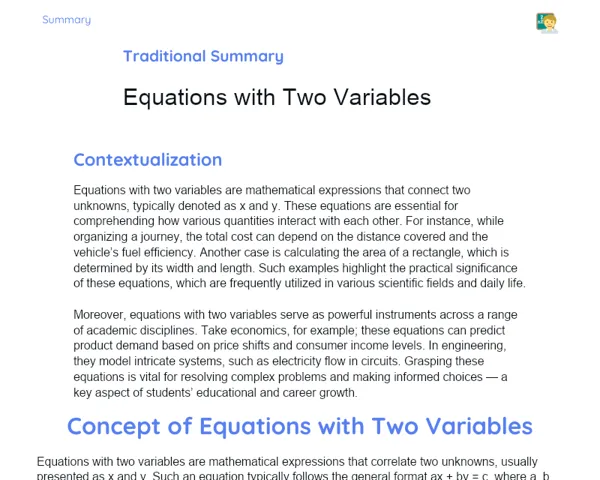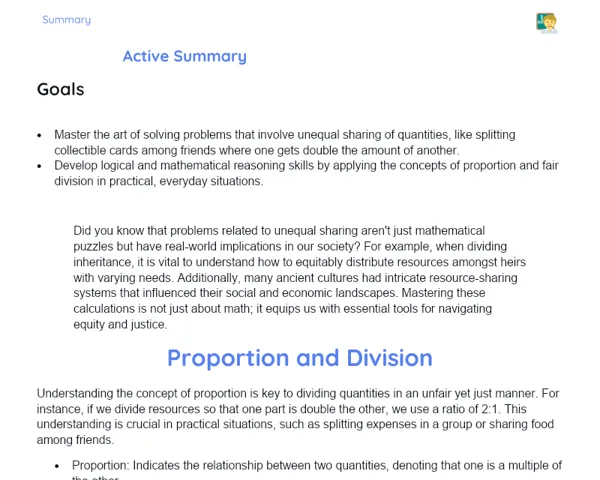Summary Tradisional | First Degree Inequality
Contextualization
First-degree inequalities are vital mathematical tools that help us express conditions and make informed decisions in varied scenarios. These inequalities involve a variable, typically denoted as 'x', and utilize inequality symbols like >, <, ≥, and ≤. The general format of a first-degree inequality is ax + b > c, where 'a', 'b', and 'c' are real numbers and 'a' is never zero. Such inequalities are particularly useful in expressing instances where a certain value must be exceeded, met, or remain below.
In our daily lives, we often come across inequalities in different contexts, such as calculating the minimum sales required to attain a particular profit or analysing various investment choices. Furthermore, these inequalities play a significant role in sectors like economics, engineering, and computer science. Acquiring the skills to solve and implement these inequalities is fundamental for enhancing critical thinking and decision-making abilities.
To Remember!
Definition of First-Degree Inequality
A first-degree inequality is a mathematical statement that employs inequality symbols (> , < , ≥ , ≤) and includes a variable, usually represented by 'x'. The standard expression of these inequalities is ax + b > c, where 'a', 'b', and 'c' are real numbers, with 'a' being non-zero. The defining feature of first-degree inequalities is that the variable appears only to the first power, meaning it isn't squared or multiplied by itself.
To understand it better, take the inequality 2x - 4 > 6. Here, 'a' equals 2, 'b' is -4, and 'c' is 6. Our aim is to discover which values of 'x' satisfy this inequality. Unlike equations, which yield a single solution, inequalities often have a set of valid solutions. This implies that the answer may consist of multiple numbers that make the inequality true.
Inequalities extensively find applications in fields like economics, engineering, and computer science by allowing us to express specific conditions that need fulfilment. For instance, they can help ascertain the least amount of resources necessary to meet a target or evaluate whether a project is viable.
Grasping the definition and structure of first-degree inequalities is crucial for tackling problems that require specific conditions and facilitating informed decision making.
-
Mathematical expression using inequality symbols (> , < , ≥ , ≤).
-
Includes a variable, usually depicted as 'x'.
-
The general expression is ax + b > c, where 'a', 'b', and 'c' are real numbers and 'a' is not zero.
Basic Properties of Inequalities
First-degree inequalities adhere to key properties that aid in their manipulation and resolution. A fundamental property allows us to add or subtract the same number from both sides of the inequality without changing its validity. For instance, consider the inequality 2x - 4 > 6; if we add 4 to both sides, it simplifies to 2x > 10.
Another essential property pertains to multiplication and division. We can multiply or divide both sides of an inequality by a positive integer without altering the inequality sign. However, if we use a negative number, we must switch the inequality sign. For example, in the inequality -2x > -8, dividing both sides by -2 changes it to x < 4.
These properties are vital for simplifying and solving inequalities, allowing us to change the inequality to a simpler expression where the solution is more easily visible. Furthermore, understanding these principles helps evade common pitfalls, such as neglecting to reverse the inequality sign when dealing with negative numbers.
Mastering the fundamental properties of inequalities is an important milestone in addressing mathematical challenges that involve specific conditions and ensuring that our solutions remain precise and dependable.
-
We can add or subtract the same value on both sides of the inequality.
-
Multiplying or dividing both sides by a positive number preserves the inequality sign.
-
Dividing or multiplying by a negative number necessitates reversing the inequality sign.
Solving First-Degree Inequalities
To solve a first-degree inequality, we follow a methodical approach that applies the basic properties of inequalities. The objective is to isolate the variable on one side of the inequality, akin to solving equations. Let’s exemplify this practice: 2x - 4 > 6.
First, we add 4 to both sides to eliminate the constant from the left side, resulting in: 2x - 4 + 4 > 6 + 4, which simplifies to 2x > 10. Next, we divide each side of the inequality by 2 to isolate 'x': 2x/2 > 10/2, yielding x > 5.
Thus, the solution to this inequality is x > 5, representing all 'x' values that exceed 5. We can graphically depict this solution on a number line by marking an open circle at 5 and shading all numbers to the right. This signifies that while 5 isn’t included in the solution, all values greater than 5 are.
Comprehending and practicing solving first-degree inequalities is essential for addressing situations that necessitate conditions of inequality. This systematic method guarantees that the solution obtained is both accurate and relevant in real-world situations.
-
Add or subtract terms to simplify the inequality.
-
Multiply or divide by constants to isolate the variable.
-
Graphical depiction of solutions on a number line.
Practical Applications of First-Degree Inequalities
First-degree inequalities have numerous practical applications across different fields and aspects of daily life. They are frequently employed to tackle problems that involve inequality conditions, such as identifying minimum or maximum thresholds for specific variables. For instance, in economics, inequalities assist in calculating the break-even point between income and expenses, or determining the least quantity of products to be sold for profitability.
Another application can be found in engineering, where inequalities ensure safety and efficiency in structures. For example, in bridge design, it’s crucial to confirm that the strength of materials surpasses the expected load, which can be formulated as a first-degree inequality to meet safety regulations.
In computer science, inequalities are vital in algorithm design for optimizing processes and resource allocation. For instance, developing a search algorithm might necessitate ensuring execution time remains below a certain threshold, depicted through a first-degree inequality.
Grasping and applying first-degree inequalities in practical scenarios is fundamental for resolving real-world issues and making informed choices. These skillsets are indispensable in various careers and everyday situations, which reinforces the importance of studying first-degree inequalities in our curriculum.
-
Used to tackle problems with inequality conditions.
-
Applications in economics, engineering, and computer science.
-
Essential for making well-informed decisions and resolving real issues.
Key Terms
-
First-Degree Inequality: A mathematical expression employing inequality symbols and involving a variable.
-
Inequality Symbols: Symbols used in inequalities (> , < , ≥ , ≤) indicating the relationship between quantities.
-
Properties of Inequalities: Rules governing addition, subtraction, multiplication, and division of terms in an inequality.
-
Graphical Representation: A method to illustrate the solution of an inequality on a number line.
Important Conclusions
In today’s session, we delved into the definition and basic properties of first-degree inequalities along with the structured approach to solve them. Understanding these inequalities is imperative, as they allow us to articulate and resolve conditions of inequality evident in numerous practical contexts such as economics, engineering, and computer science.
By applying concepts of first-degree inequalities to everyday challenges, like assessing the minimum sales required for profitability, we've highlighted the significance of these mathematical tools in guiding informed decisions. The graphical representation of solutions also aids in visualising and interpreting the outcomes more effectively.
The mastery of first-degree inequalities extends beyond academic theory, reaching into tangible real-world situations that demand precise and efficient solutions. We encourage everyone to further explore this topic to enhance their problem-solving capabilities and apply this knowledge in future careers and daily life.
Study Tips
-
Revisit the examples and exercises tackled in class to reinforce understanding of the properties and methods for resolving first-degree inequalities.
-
Practice additional problems involving first-degree inequalities, especially those that relate theoretical concepts to practical real-life situations.
-
Utilise extra resources, such as educational videos and online content, to discover varying methods and strategies for solving inequalities and understanding their relevance across different disciplines.



